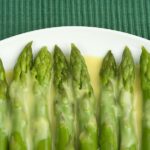You can be as simple or fancy as you want with artichokes.
The simplest way to cook an artichoke is to trim away the thorny ends and stand it upright in a deep saucepan large enough to hold them snugly. Cook them covered in two inches of gently boiling salted water for 35 minutes or until the base can be pierced easily with a fork. Add a few drops of soil and a dash of lemon juice to the water to make the leaves glisten and prevent them from darkening. Lift out the cooked artichokes and turn them upside down to drain. You can serve them right away with melted butter. If you want to stuff them, gently spread the leaves and remove the choke or thistle portion from the center with a metal spoon.
All artichoke articles:
How to Plant and Grow Artichokes
How to Harvest and Store Artichokes
Artichoke Growing Problems: Troubleshooting
How to Cook and Serve Artichokes
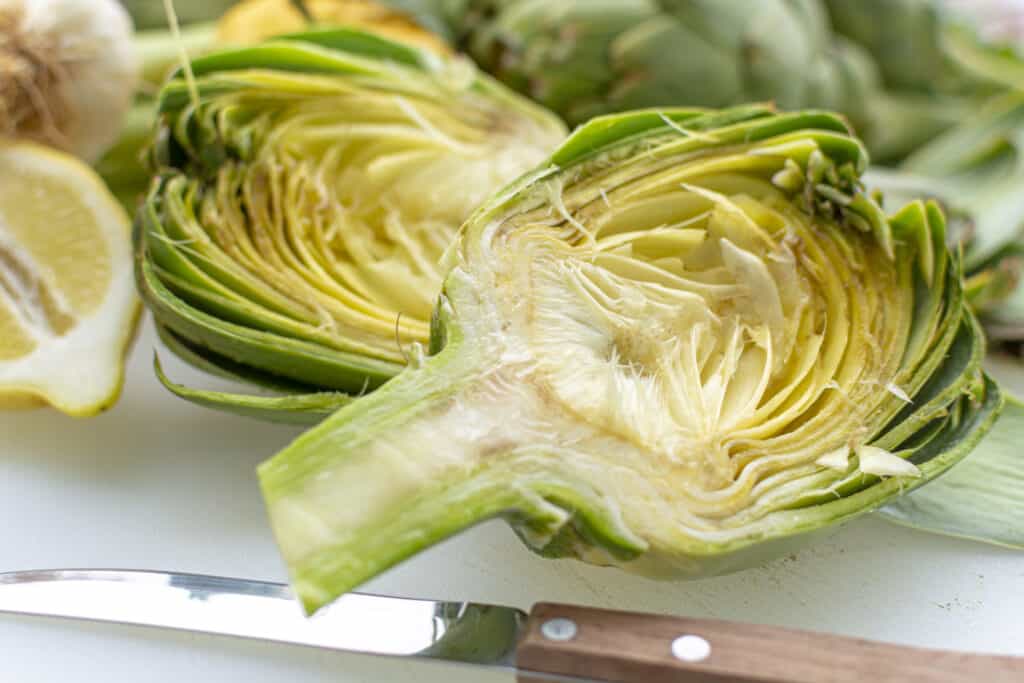
Artichokes are simple finger food. Cooked whole, simply pull off the outer leaves one at a time and dip the tender, fleshy end of the base of each leaf in a sauce or dressing, or butter. The fuzzy center or choke has a fleshy bottom or heart which you can eat with a fork after removing the thistles.
Kitchen Helpers from Amazon:
- Oster Vegetable Steamer
- Chef’s Knives Set of 6
- EZ Off Jar Opener for Weak Hands
- Pepper Core Remover Stainless Steel
- Kitchen Utensils – Set of 35
There are two harvest seasons for artichokes: a short one in early autumn and the main artichoke harvest from early spring to late spring.
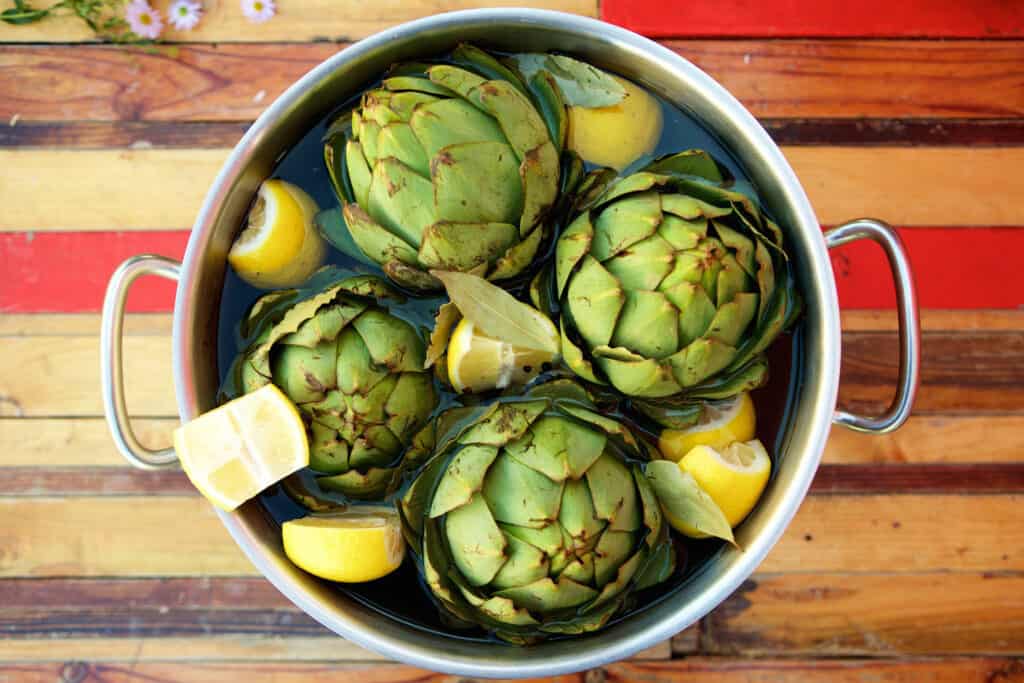
How to choose an artichoke
- Select artichokes that have crisp, tightly packed, or closed leaves that are deep green in color. The leaves of a fresh artichoke will squeak when they are pressed together.
- An artichoke should be heavy for its size. Light-feeling chokes have begun to dehydrate.
- Avoid chokes that are tough, woody, or dry or that have leaves that have spread apart. If the cut end is black or the leaves have started to open, the choke is not fresh.
- Size is not an indication of age when it comes to artichokes rather it is an indication of where on the plant the choke grew: the large chokes at the top and the smaller ones sprout from side stalks. The larger the artichoke, the larger the fleshy heart.
- Brown streaks may be a sign of age, but rather a “kiss of the frost.” Artichokes will be more intensely nutty-flavored after a frost.
Kitchen Helpers from Amazon:
- Oster Vegetable Steamer
- Chef’s Knives Set of 6
- EZ Off Jar Opener for Weak Hands
- Pepper Core Remover Stainless Steel
- Kitchen Utensils – Set of 35
- Rachel Ray Non-Stick Cookware 12pcs
How to store artichokes
- Artichokes are best used soon after harvest.
- Refrigerate artichokes for up to 1 week in a plastic bag.
How to prep an artichoke for cooking
- Before cooking an artichoke, plunge it into cold water to dislodge any debris trapped in the leaves.
- Then cut the stem so that it is even at the bottom and trim off any tough, outer leaves with a paring knife.
- Next, snip off the prickly leaf tips.
- Rub cut edges with lemon juice to avoid discoloration or soak the entire choke in water and lemon juice.
Favorite artichoke recipes
Artichokes and mint side salad
Artichokes steamed and stuffed
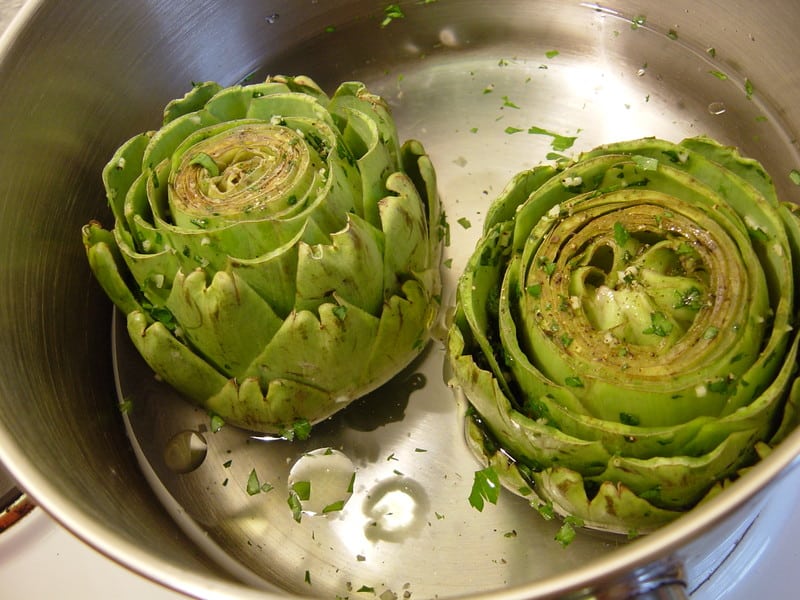
How to cook an artichoke in a pot
- Stand the artichoke in a stainless steel pot with 2-3 inches (5-7.5 cm) of water so that it is not completely water cooked.
- Cook or steam the choke until the stem end is tender–about 20 to 40 minutes.
- Remove the thistle-like choke and the small purple leaves covering it with a teaspoon after cooking.
Artichoke cooking instruction step-by-step
Ingredients: Two medium-sized artichokes
Prep time: 5 minutes
Cooking time: 40 minutes to 1 hour
What you need:
- Steamer basket or heatproof colander or strainer
- Large pot
- Chef’s knife and cutting board
- Bowl
Instructions:
- Bring water to a boil. Bring a few inches of water to a boil in a lidded large pot that fits a steamer insert.
- Prepare the artichokes: Cut the stems off each artichoke bud at the base.
- Cut the top off each bud: Cut about 1 inch from the top of each bud.
- Trim the sharp points off the leaves: Use a pair of kitchen shears.
- Rinse the artichokes: Rinse the buds under cold running water. Separate the leaves to remove any dirt or grit. Dunk the buds in acidulated water (water plus the juice of 1 lemon) to keep them from turning brown.
- Steam the artichokes 40 to 60 minutes: Set the buds in a steamer basket or heatproof colander or strainer inside the pot. Reduce the heat to a gentle simmer, cover the pot, and steam for 40 to 60 minutes.
- Check to make sure they are done: The buds are ready when you can pull off an outer leaf with tongs without much effort. Let them stand until they are cool.
- Serve with butter or sauce. Serve the artichokes with warm butter or a dipping sauce
How to cook an artichoke in a steamer
- To steam an artichoke, place it in a steamer basket over 3 inches of boiling salted water, cover, and cook until tender: 15 to 30 minutes for smaller chokes, about 45 minutes for large ones.
- To test if the artichoke is done, tug on one of the leaves; if it comes off easily the artichoke is done.
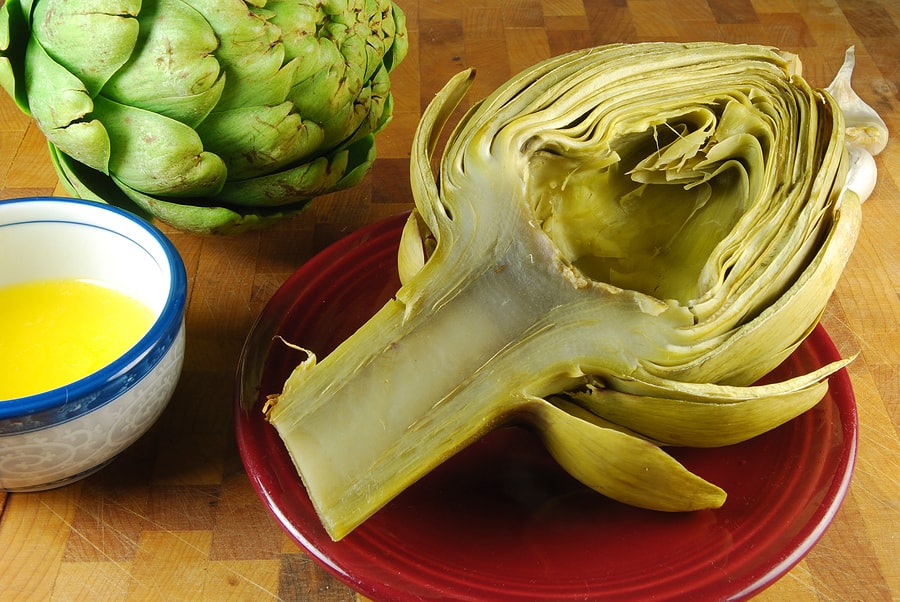
How to eat an artichoke
- Pull off each leaf; dunk it in the sauce; put it in your mouth and pull, scraping the tender flesh through your teeth.
- Once the leaves are stripped away and eaten, the heart or center of the artichoke is left. The heart is surrounded by prickly fibers. Peel away these fibers (they are not edible) to get to the meaty center.
- The tender nut-flavored heart can be cut into bite-sized pieces and dipped in warm butter or sauce and eaten.
How to serve artichokes
- Artichokes are always eaten cooked: boiled or steamed. Once cooked, they can be served hot, warm, or cold.
- Serve with béchamel, butter, or hollandaise sauce.
Preparing baby artichokes
- Baby artichokes can be trimmed, cooked, and eaten whole.
- Whole cleaned baby artichokes can be deep-fried to a golden brown.
- Use baby artichokes in stews or marinated in olive oil, vinegar, and garlic as part of an antipasto.
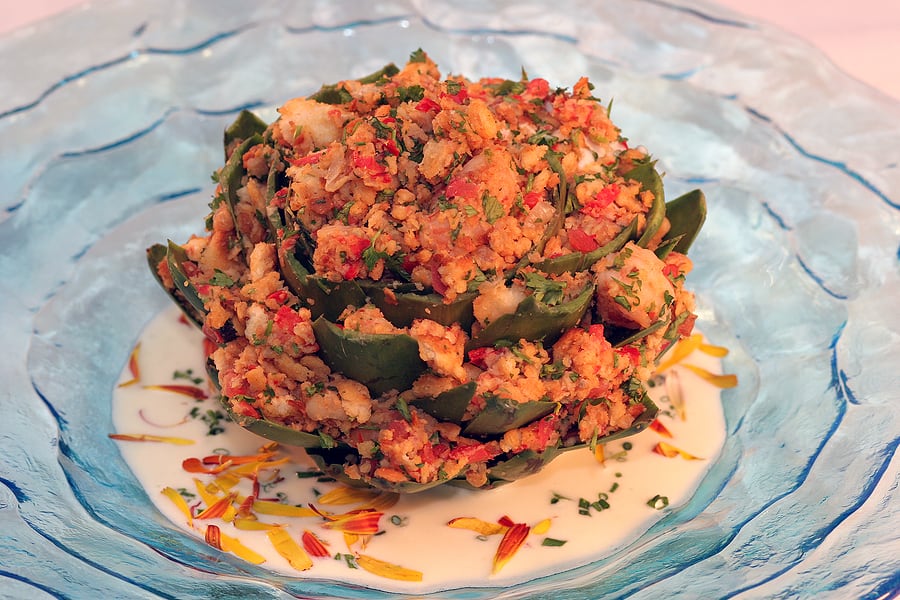
How to stuff artichokes
- Stuffed artichokes are a favorite in Arabic cuisine.
- To stuff an artichoke, spread open the leaves and remove some of the center leaves; cut off some of the hard tips of the outer leaves. For an Italian-style stuffing, use seasoned breadcrumbs with anchovies, topped with tomato sauce.
- Stuff steamed artichokes with rice, ground meat, sausage, chicken, vegetables, cheese, or combinations, and bake until bubbling.
Serving artichokes and wine
- The fleshy part of the artichoke heart—which cooks call the “fond”—and leaves contain an acid called cynarin. Cynarin stimulates the sweetness receptors on the tongue and makes things that you taste after eating an artichoke seem sweet. So if you decide to drink wine when you eat artichokes, choose a wine with acidity such as a Chenin Blanc. And serve artichokes with neutral-tasting foods such as pasta.
Artichoke nutrition
- Artichokes contain a small amount of potassium and vitamin A and no fat.
- Medium-cooked artichoke will have from 8 to 44 calories.
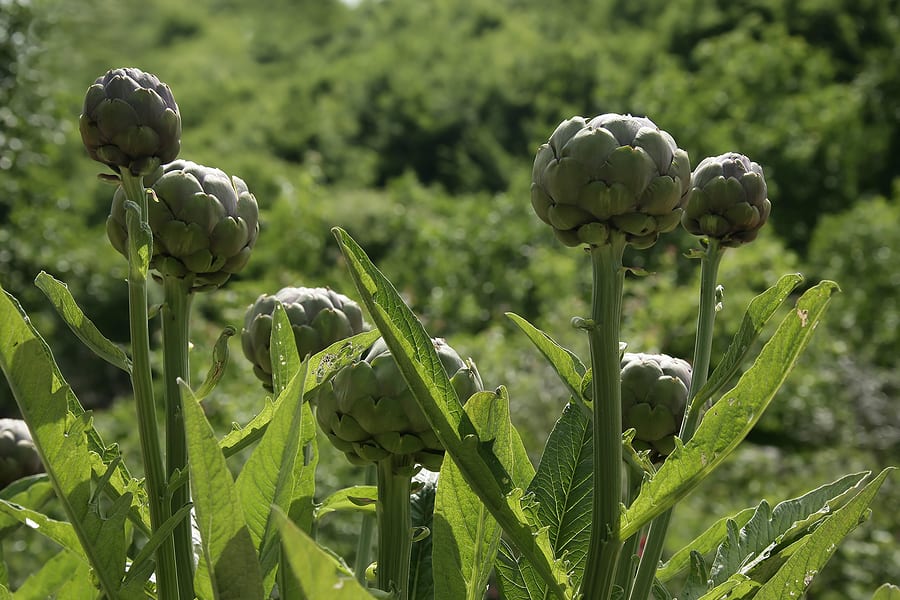
Get to know artichokes
- The artichoke is an edible thistle—you eat the flower buds before they open.
- There are all sizes of artichokes. The largest—called jumbo chokes–come from the end of the plant’s central stem; the smallest—called baby artichokes–from the lateral shoots lower down on the plant.
- There are about 50 varieties of artichokes. The most popular for cooking are globe artichokes. “Green Globe” is the variety you will most likely find at the farm market. It is round, fat, and green—a green globe—and will yield the most flesh for your enjoyment.
- Almost all artichokes must be cooked—usually steamed or boiled–before they can be eaten. One variety, “Provencal”, is a small purple choke that can be eaten raw.
- Artichokes can range in weight from an ounce to a pound or more. Jumbo artichokes can be stuffed with meat or seafood and vegetables and baked. Baby artichokes can be sautéed, fried, roasted, or marinated and used in salads.
- The first artichokes appeared in North Africa or Sicily. The cultivation of artichokes spread from Sicily to Southern Italy more than 2,000 years ago. The ancient Romans enjoyed artichokes and were the first to preserve them in vinegar or brine, a practice that is common today.
- Catherine de Medici put artichokes on the culinary map in the fourteenth century when she left Florence to become the queen of France and took her cooks and artichokes along.
- French colonists introduced artichokes to Louisiana and to the United States.
- The largest artichoke-producing countries are Italy, Spain, and France which account for more than 80 percent of the crop worldwide. In the United States, almost the entire commercial artichoke crop is grown along the central coast of California.
- The botanical name for artichoke is Cynara scolymus.
Also of interest:
How to Plant and Grow Artichokes
How to Cook and Serve Artichokes
Artichokes and Mint Side Salad
Artichokes Steamed and Stuffed
Three Artichoke Dipping Sauces
Artichoke Growing Problems Troubleshooting
How to Plant and Grow Jerusalem Artichokes – Sunchokes
Jerusalem Artichoke – Sunchoke Plant Starting Tips
How to Harvest and Store Jerusalem Artichokes – Sunchokes
Five Ways to Cook and Serve Jerusalem Artichokes – Sunchokes
Related articles:
Best Herbs for Container Growing
Garden Planning Books at Amazon:
- Vegetable Garden Almanac & Planner
- Kitchen Garden Grower’s Guide Vegetable Encyclopedia
- Vegetable Garden Grower’s Guide
- Tomato Grower’s Answer Book
More kitchen tips:
Bring your harvest to the table. Kitchen prep tips and easy recipes for the vegetables you grow. Click below for vegetable prep and recipes you can use now.
- Almonds
- Apples
- Apricot
- Aprium
- Artichoke
- Arugula
- Asparagus
- Avocado
- Bamboo Shoots
- Banana
- Basil
- Beans, Dried
- Beans. Long
- Beans, Shell
- Beans, Snap
- Beets
- Bitter Melon
- Blackberry
- Bok Choy
- Broccoli
- Broccoli Raab
- Brussels Sprouts
- Cabbage
- Cardoon
- Carrots
- Cauliflower
- Celeriac
- Celery
- Chard
- Chayote Squash
- Cherimoya
- Cherries
- Chestnut
- Chickpea
- Chinese Cabbage
- Chives
- Cilantro
- Citron
- Clementine
- Collards
- Coriander
- Corn, Sweet
- Corn, Baby
- Corn Salad, Mache
- Cranberry
- Cress
- Cucumber
- Daikon
- Dandelion
- Dill
- Eggplant
- Endive, Belgian
- Endive and Escarole
- Fava Beans
- Fig
- Florence Fennel
- Garlic
- Ginger
- Grapefruit
- Grapes
- Guava
- Horseradish
- Jerusalem Artichoke
- Jicama
- Jujube
- Kale
- Kiwifruit
- Kohlrabi
- Kumquat
- Leeks
- Lemongrass
- Lemons
- Lettuce
- Lime
- Mache (Corn Salad)
- Mandarin Orange
- Mango
- Maple Syrup
- Marjoram
- Melons
- Michihili
- Mint
- Mizuna
- Mushrooms
- Mushrooms, Cremini
- Mustard Greens
- Napa Cabbage
- Nectarine
- Okra
- Olives
- Olive oil
- Onions
- Oranges
- Oregano
- Parsley
- Parsley Root
- Parsnips
- Passion Fruit
- Pawpaw
- Peaches
- Pears
- Peas, Garden Snap
- Peas, Snow
- Pei Tsai
- Peppers, Chili
- Peppers, Sweet
- Persimmon
- Pineapple
- Pineapple Guava
- Plantain
- Plums
- Pluots
- Pomegranate
- Potatoes
- Prickly Pear
- Pumpkin
- Quince
- Radicchio
- Radishes
- Raspberries
- Rosemary
- Rhubarb
- Rutabaga
- Sage
- Salsify
- Sauerkraut
- Savory
- Shallots
- Sorrel
- Spinach
- Squash, Summer
- Squash, Winter
- Strawberries
- Sunchokes
- Sunflower
- Sweet Potato
- Swiss Chard
- Tangerine
- Taro
- Tarragon
- Thyme
- Tomatillo
- Tomato
- Turnip
- Turnip Greens
- Yams















